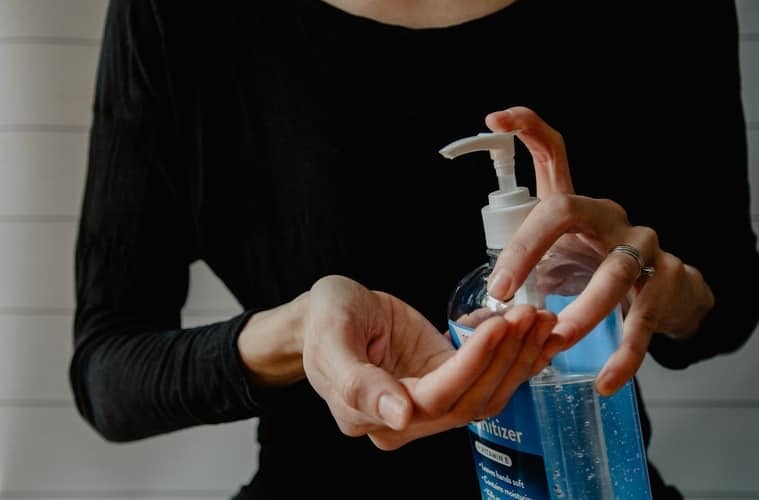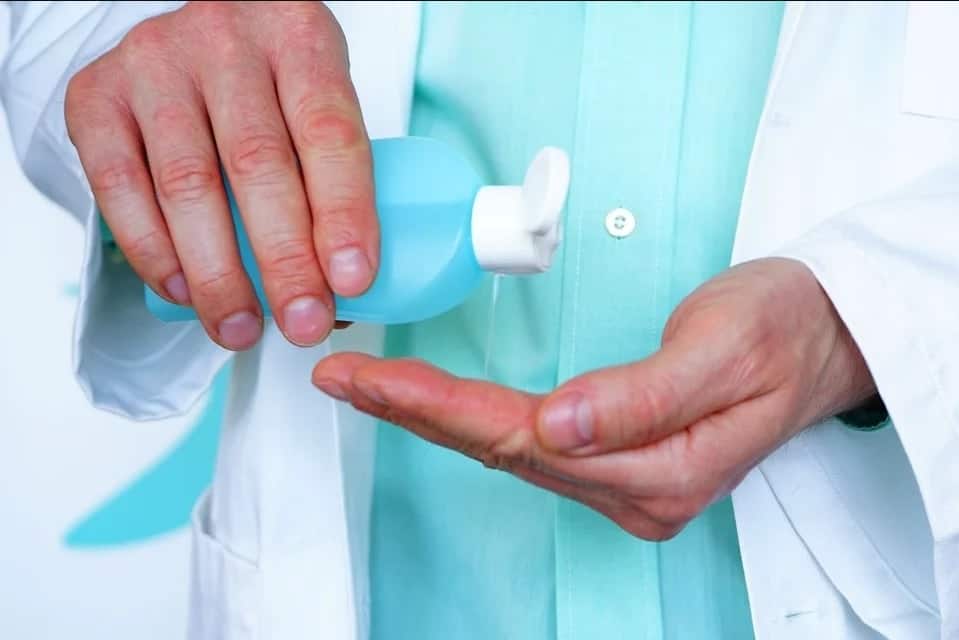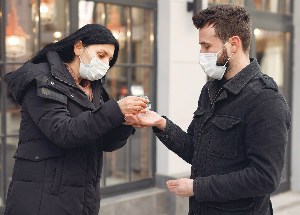Antiseptics and disinfectants are chemicals or substances that contain them as the compounds to stop the development of dangerous microorganisms and destroy them. Both of them have appeared fairly recently.
They contain chemicals that have been known as widely popular cleaning agents for hundreds of years. Sometimes people think that there is no difference between them.
Both disinfectants and antiseptics are used by medical professionals and many other people to kill microorganisms that may be the cause of various diseases. However, these substances are completely different.
In this article, you will find information about the components of disinfectants and antiseptics. You will learn in what cases you should use them, for which purposes, and how to do it correctly. Also, I will provide you with DIY recipes, so that you will be able to make your disinfectant and antiseptic at home.
Disinfectant vs Antiseptic: What Is the Difference?
As you already know, people tend to confuse these two substances for one. So, what is the difference between antiseptic and disinfectant? They are differentiated by their intended place of usage.
Antiseptics should be applied to our body, especially hands, and very often, doctors use them to prevent the appearance of infection on wounds or surgical incisions.
Disinfectants are used on all other surfaces, from operating rooms to kitchen counters. However, they serve the same purpose – destroying potentially dangerous microbes.
Antiseptics: Purpose, Usage, Components, and More

Antiseptics are chemical substances, which are used to kill and stop the development of microbes that may lead to various diseases or infections. These agents disrupt the normal course of biochemical processes in microorganisms and create adverse conditions for their development and reproduction. By using an antiseptic regularly, you decrease your chances of catching a virus.
Antiseptic Purpose and Usage
What are antiseptics used for? Their main purpose is to kill germs on skin and mucous membranes. To protect yourself from viruses and germs, it is important to apply some antiseptic on your hands regularly. And this is essential not only during the COVID-19 spread. Here are the main recommendations for using antiseptics correctly and effectively:
- The antiseptic should cover your hands completely. Check the antiseptic instructions, sometimes the manufacturer provides information about the exact amount that should be applied.
- Rub your hands with the antiseptic for at least 30 seconds.
- A lot of germs can be found under your nails, so take your time and apply some of the substance there as well.
- If you tend to use an antiseptic frequently, apply some hand cream after it to avoid dry skin and cracking.
- Store the antiseptic bottle in a place that is impossible to reach for children. The substance’s components are very dangerous and toxic if swallowed.
Does an antiseptic kill bacteria and viruses? Yes, of course. However, it can be applied only to the skin.
Examples of Antiseptics, Components, and Antiseptic Solution DIY Recipes
Buying an antiseptic in a store is not the only way of getting it. Instead, you can create one yourself.
Option 1. For this easy antiseptic recipe, you will need:
- 28 fl.oz. ethyl alcohol 96%;
- 1.4 fl.oz. hydrogen peroxide 3%;
- 0.50 fl.oz. glycerol 98%.
Take the alcohol and pour it in a measuring container. Then add the other two ingredients in the stated amount. After that, add a little amount of distilled water and immediately close the container. Wait 3 days before using it.
Option 2. Another way to prepare an antiseptic at home is by mixing:
- 1.7 fl.oz. medical alcohol 90%;
- 1 fl.oz. Glycerin;
- Essential oil (orange, vanilla, peppermint).
Combine the components and pour it into a spray bottle. This recipe is great for people with dry skin, as it contains an essential oil that helps with moisturizing it.
Over-the-counter antiseptic solutions contain all possible ingredients, such as chlorine, metals, alcohols, antibacterial dyes, peroxides, and many others. The most common antiseptics include:
- Alcohols. They sometimes are also called surgical spirit. Alcohols, such as ethanol, are usually used by doctors to apply on skin before doing a surgical operation, or before giving an injection.
- Iodine. It is used for minor wound disinfection. However, some studies claim that it may prolong the healing time. It is a very strong antiseptic, as iodine can kill even the strongest microorganisms – spores.
- Super-oxidized solutions also referred to as SOS. They are widely used for medical purposes.
Disinfectants: Purpose, Usage, Components, and More

Disinfectants are chemical agents that kill microorganisms on various surfaces. They cause irreversible changes in the cell’s protoplasm and prevent bacteria from spreading by destroying them completely. Disinfectants are used to kill microorganisms that live in the environment, which is one of the measures that must be taken to prevent infectious diseases. According to the CDC, disinfectants can eliminate various microorganisms, but not spores.
Disinfectant Purpose and Usage
Where to use a disinfectant? It can be applied only to non-living objects. For example, you can use it to disinfect bathrooms, floors, kitchen counters, and anything else that you find in your house. A certain type of disinfectant, hydrogen peroxide, is used by medical personnel to disinfect surgery supplies and to sterilize rooms.
However, you should know that some microorganisms have resistance to disinfectant substances. This is why sometimes such agents don’t destroy the germs completely but only make them harmless for humans.
To make your house as much bacteria-free as possible, you need to disinfect everything. Here is how to do it properly:
- First of all, you will need to clean all possible surfaces that you find in your house with soap and water to remove dust and dirt.
- Then take a disinfectant spray of your choice and apply it to all of those surfaces. Also, instead of the spray, you can use disinfecting wipes. They are as effective and have the same power as the spray.
Does disinfectant kill bacteria and viruses? Yes and no. In most cases, this chemical agent destroys them completely. But in some cases, with some types of bacteria and viruses, a disinfectant spray only stops them from developing and makes them safe for people.
Related Post:
- Sanitization vs Disinfection vs Sterilization: What’s the Difference?
- Does Fabuloso Kill Germs
- Is Ammonia a Disinfectant
Examples of Disinfectants, Components, and DIY Recipes
A disinfectant usually comprises alcohol and some other additives. According to the CDC, the following ingredients may be found in such a chemical agent – iodophors, chlorine, phenolics, formaldehyde, peracetic acid, and other substances. You can buy a ready-made disinfectant or you can make one by yourself. Read on to find out how to DIY a disinfectant.
Option 1. Here is a recipe for a multi-purpose disinfectant spray. You will need such ingredients:
- 1 ½ cups of alcohol (100 proof or higher)
- ½ cup white distilled vinegar
- 40-45 drops of lavender, or any other essential oil
Mix everything in a spray bottle. If you use high-proof alcohol, be very careful with the substance and don’t use it on marble, as it can damage the surface.
Option 2. This one has the same power and will provide you with the same effect as the previous one. You will need:
- ¼ cup white vinegar
- ¾ cup distilled water
- 5 drops of tea tree oil
- 5 drops of any essential oil, for example, lavender oil will do fine
Prepare an 8-ounce bottle, preferably a spray bottle and mix everything in it. Here are some examples of disinfectants:
- Aldehydes. This type has a powerful microbiocidal activity. However, some bacteria are resistant to this chemical agent.
- Oxidizing agent. This group includes chlorine and oxygen. They are used to disinfect hospital rooms or any other surfaces. They have the power to kill even exotic animal viruses.
- Phenolics. This is a widely spread ingredient in household disinfectants, even in liquid soap or mouthwash.
Popular FAQ’s
The best possible way to destroy almost all of the dangerous microorganisms surrounding you and keep yourself from catching a virus is to use antiseptics and disinfectants frequently. Read on to find out the main differences between them.
What is the Difference Between Antiseptic and Disinfectant?
The main difference is in the way they are used. Antiseptics must be used only on the skin, and disinfectants are intended for use on various non-living surfaces, such as floors and counters. That’s why they differ in composition too.
Is a Home-Made Antiseptic or Disinfectant as Powerful and Effective as a Ready-Made One?
Yes. If you use the right ingredients and the correct amount of them, your DIY antiseptic or disinfectant will be able to destroy all kinds of bacteria and viruses.
The Bottom Line: Antiseptic vs Disinfectant
Now you know how to differentiate between antiseptic and disinfectant. Both of these chemical agents do a great job of stopping the development and getting rid of various viruses and germs. However, keep in mind that they are not completely the same. Yes, they do serve the same purpose – destroying dangerous microorganisms, but they vary in their usage.
When you need to clean your hands of microorganisms, remember that you can only use an antiseptic for such a purpose. And if you want to get rid of all possible bacteria in your house, you should buy or make yourself a disinfectant. According to the CDC, it is recommended to disinfect objects that are regularly touched by people in a house to be safe from all dangerous diseases, including COVID-19.
To prevent yourself from catching any virus, you must use an antiseptic and a disinfectant regularly. From time to time, apply a couple of drops of an antiseptic solution on your hands to make them clean and germ-free. And don’t forget to disinfect your surroundings with a specialized spray. You can apply it particularly everywhere – on the floor, doorknobs, kitchen counters, or any other area of your house that people often touch.
I hope this article was helpful and that now you understand the difference between disinfectant and antiseptic. Stay safe!
References:
- Antiseptic (Wikipedia):
https://en.wikipedia.org/wiki/Antiseptic - Iodine (National of Dietary Supplements):
https://ods.od.nih.gov/factsheets/Iodine-Consumer/ - Introduction, Methods, Definition of Terms (Centers for Disease Control and Prevention, National Center for Emerging and Zoonotic Infectious Diseases): https://www.cdc.gov/infectioncontrol/guidelines/disinfection/introduction.html

